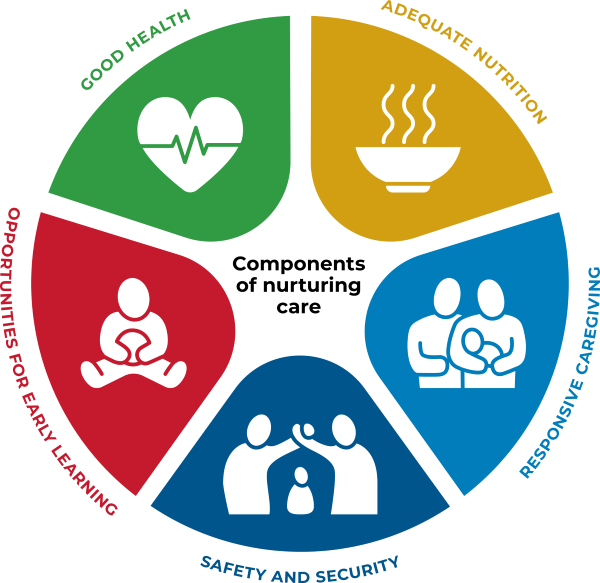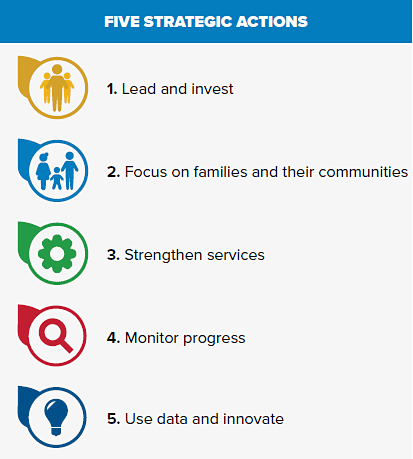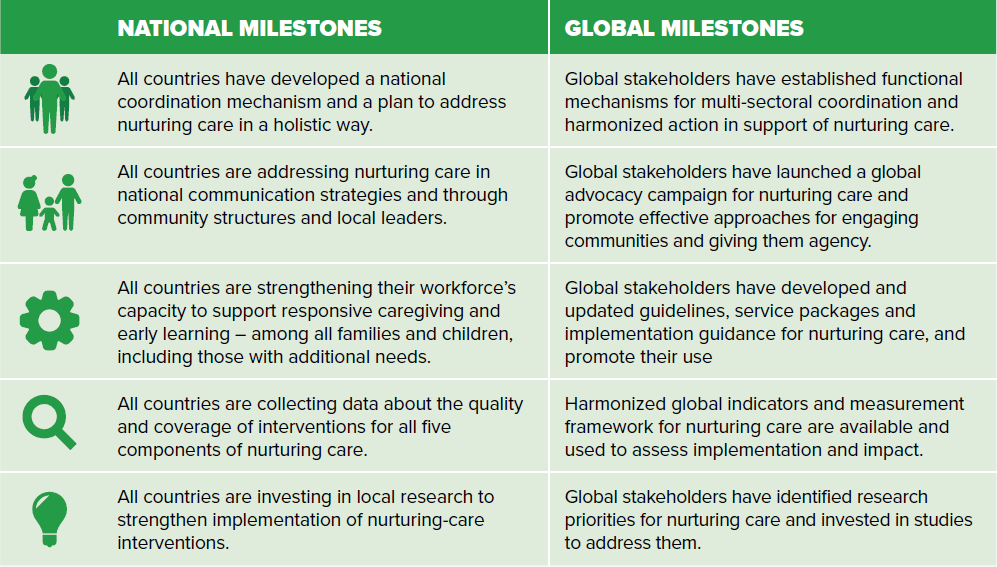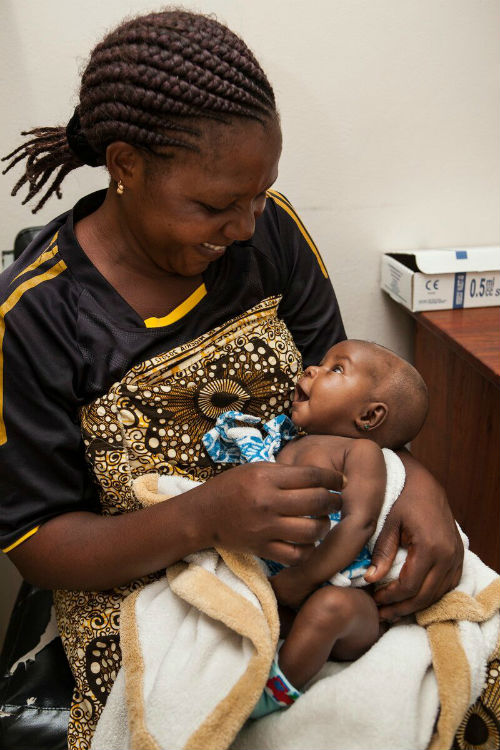[print-me]
Investing in early childhood development is one of the best investments a country can make to boost economic growth, promote peaceful and sustainable societies, and eliminate extreme poverty and inequality1,2. Equally important, investing in early childhood development is necessary to uphold the right of every child to survive and thrive.3
All children need nurturing care to develop their full potential – it is vital for healthy growth and development. The time from pregnancy to three years of age, when the brain is most susceptible to environmental influences, is crucial4. Nurturing care not only promotes physical, emotional, social and cognitive development, it also protects young children from the worst effects of adversity. It produces lifelong and inter-generational benefits for health, productivity and social cohesion.
Nurturing care encompasses young children’s needs for good health, optimal nutrition, security and safety, opportunities for early learning and responsive caregiving5. Parents, families and other primary caregivers are the main providers of nurturing care. Policies, programmes and services must therefore be designed to enable them and their communities to meet all the needs of young children.
The Sustainable Development Goals (SDGs) and the Global Strategy for Women’s, Children’s and Adolescents’ Health have embraced young children’s development, seeing it as central to the transformation that the world seeks to achieve by 20306,7. Indeed, one of their shared targets is to ensure that all boys and girls have access to quality early childhood development (SDG target 4.2).
The cost of inaction is high
Poverty, malnutrition, insecurity, gender inequities, violence, environmental toxins and caregivers’ poor mental health are among the major risk factors for sub-optimal child development. According to estimates based on the risk factors of poverty and stunting alone, more than 40% of children in low- and middle-income countries – almost 250 million children – are at risk of not attaining their full development potential8.
While children living in extreme poverty and those in conditions of conflict, disaster or displacement are at greatest risk, children all over the world may be exposed to adversities that impair their optimal development9.
Without intervention, adults affected by adversity in early childhood are estimated to earn almost a third less than the average adult income in their country. These individual costs add up, constraining wealth creation and national earnings. Lack of investment in early childhood development, and addressing the long-term consequences, are estimated to cost countries more than what they spend today on health10.
COMPONENTS OF NURTURING CARE

Working together for young children
Global institutions have prioritized early childhood development in their programmes of work. Now they need to work together in a unified way towards shared goals, and to inspire more governments and other stakeholder groups to invest in early childhood development. The time to act is now.
In response to this urgent need, the World Health Organization, UNICEF and the World Bank, in collaboration with the Partnership for Maternal, Newborn & Child Health, the Early Childhood Development Action Network and many other partners, have developed this Nurturing Care Framework, which was launched during the Seventy-first World Health Assembly in May 2018.
The Framework provides an evidence-based road map for action and outlines how policies and services can support parents, families, other caregivers and communities in providing nurturing care for young children. It calls for attention to be paid to communities where children are most at risk of being left behind.
The Nurturing Care Framework identifies a set of best practices, based on programmes that have proven effective in improving early childhood development in high-, middle-and low-income countries. Effective national programmes are driven by strong and sustained political commitment and a determination to reduce inequity, poverty and social injustice.5 They combine evidence-informed policies, services and public communication to improve awareness of and knowledge about early childhood development.
Investments are directed towards creating enabling environments and providing services and support for families and caregivers, motivated by both commitments and strong accountability mechanisms.
In line with these best practices, the Framework includes five strategic actions, accompanied by national and global milestones to 2023.
For each strategic action, the Framework proposes five country-level actions that need to be led and coordinated by governments and supported by a broad array of stakeholders.
Making nurturing care a reality for all children
Intersectoral collaboration is important to ensure a continuum of nurturing care – families and caregivers need comprehensive and integrated support systems. The health sector has an important role because of its close contact with young children and their families during the early years.5 However, accelerating action on nurturing care requires whole-of-government action: contributions from many other sectors are also needed, including education, child protection and social protection.

The Framework depends on a whole-of-society approach, mobilized through a coalition of parents and caregivers, national and local governments, civil society groups, academics, the United Nations, development partners, the private sector, educational institutions and service providers, to ensure that every child gets the best possible start in life.
Stakeholders must plan together, implement by sector and by level of government, and monitor together. Effective coordination and accountability are essential, although the mechanism will vary from country to country.
The Framework calls on all governments and all stakeholders to take ownership of early childhood development in order to strengthen our investment in the sustainable future of our children and our shared world. These are the core values driving the SDGs, and the deep desire of parents and caregivers everywhere. Only if all children are enabled to survive and thrive – with no child left behind – will it be possible to transform the health and human potential of all people in all societies everywhere.
MILESTONES TO BE ACHIEVED IN THE NEXT 5 YEARS (BY 2023)

References
- Heckman JJ. Skill formation and the economics of investing in disadvantaged children. Science. 2006;312(5782):1900–2.
- Shonkoff JP. Leveraging the biology of adversity to address the roots of disparities in health and development. Proc Natl Acad Sci U S A. 2012;109 Suppl 2:17302–7.
- The United Nations Convention of the Rights of the Child. New York: United Nations; 1989.
- Lagercrantz H. Infant brain development: Formation of the mind and the emergence of consciousness. Switzerland: Springer International Publishing; 2016.
- Richter LM, Daelmans B, Lombardi J, et al. Investing in the foundation of sustainable development: pathways to scale up for early childhood development. Lancet. 2017;389(10064):103–18.
- Survive, Thrive, Transform – The Global Strategy for Women’s, Children’s and Adolescents’ Health (2016 – 2030). New York: United Nations; 2015.
- Transforming our World: The 2030 Agenda for Sustainable Development. New York: United Nations; 2015.
- Black MM, Walker SP, Fernald LCH, et al. Early childhood development coming of age: science through the life course. Lancet. 2017;389(10064):77–90.
- Britto PR, Lye SJ, Proulx K, et al. Nurturing care: promoting early childhood development. Lancet. 2017;389(10064):91–102.
- Hoddinott J, Maluccio JA, Behrman JR, Flores R, Martorell R. Effect of a nutrition intervention during early childhood on economic productivity in Guatemalan adults. Lancet. 2008;371(9610):411–6.





